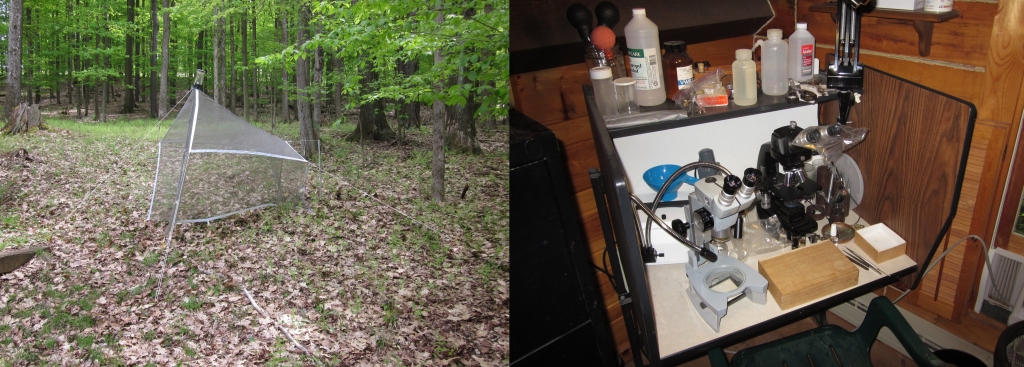Head Shots, External Links, and More
March 17, 2012I've added a lot to the site in the last week and a half. All of the eastern Laphria s. str. now have links to photos of the head in profile, with each set up to the extent possible as a silhouette -- sort of an updated version of the drawings in Hull's monograph Robber Flies of the World. All profiles except two (for L. affinis and L. macquarti) are of males. I started with affinis before I decided to just shoot one sex; I will replace that shot later with another. In the case of macquarti for some reason the photo of the male did not process correctly, and I substituted one from a female. A few of the other shots are substandard in one way or another and will probably eventually be replaced as well.
I was actually initially planning to use head-on shots showing the face, mystax, and beard instead of the profiles, but after taking just one realized that it would be next to impossible to edit out the thoracic vestiture. In other words, the shot looked really busy, and I couldn't figure out a way to fix it. Such shots could be important aids to identification though. I will probably add them later anyway.
I am going to add these head photos for all of the species in Laphria s. str., Choerades, and the two new genera. The shots for the western Laphria s. str. will come next, as I replace the habitus shots with either stacked versions, or versions without distracting highlights. I'll try to take some of these next weekend. I tried to replace most of the substandard habitus photos for the eastern Laphria s. str. last week. I still have a few eastern species to go.
This photography takes a lot of time; in the last three weeks I have spent nearly 60 hours of hard work on this site, most of which has been taking, processing, or editing photos. So it might require a few weeks to get the photographs of western Laphria completed.
It's also been pointed out to me, and correctly, that the species write ups need an associated photo of the entire fly, from the side. The problem with such shots, in my opinion, is that they are often visually unappealing, with the head at an odd angle, the legs going off in all directions, and the abdomen doubled under. Nonetheless, the color and length of the tuft of hair in front of the wings, the tuft of hair in front of the halteres, and the vestiture of the tibiae are all important characters. These characters can only be seen in their entirety by viewing the fly from the side. So eventually I will work out something, that I consider artistically sound.
From now on, when I collect specimens, I plan to pin several of each species in poses intended strictly for photography. When I went to photograph heads I was amazed at the number of specimens with legs occluding my view. A few extra pins to hold the legs in place until after they have dried should fix that. Extending the abdomen and terminalia would also be a good idea.
I'd been thinking about illustrating the keys, and have decided against it. I like the "clean" unencumbered look for the site as a whole, for the blog, and particularly for the keys. Adding in-line photographs to the keys would destroy that Spartan look I'm trying to achieve. Rather, I believe that for several groups of related species, I will add "summary" sheets, which spell out the differences with photographs or drawings or more probably both. There are several of these groups, the species in which even I have a hard time placing without some aid. One for example includes Laphria macquarti, L. floridensis, L. nigella, and one or two melanic forms which may be new species. Judging from the number of misidentified specimens I've seen, another includes L. flavicollis, L. virginica, L. divisor, and one cryptic new species I've identified. A third includes all the varieties of L. thoracica and one new species. A fourth includes several species grouped around L. grossa, again with some new forms. And there are many other similar groups for the western Laphria s. str. and for Choerades and the two new genera. I believe virtual "plates" showing how to distinguish the species in each of these subgroups would have much more value than having all the illustrations thrown together in a single key.
For the eastern Laphria s. str. I added links to the Laphriine portion of Herschel Raney's webpage on the Robber Flies of Arkansas. His site has some of the best live shots of Laphriini I've ever seen, and certainly the most extensive. It covers much more than just the Laphriini, or even the subfamily Laphriinae; but for the former in many ways is complimentary to this site. I also asked his permission; since there were so many links.
Last, for each species in any of the genera with a type specimen at the Museum of Comparative Zoology (MCZ) at Harvard, I linked to the photo species-pages they have provided for reference in their Type Database. To my knowledge the MCZ is the only museum with photographs of it's types freely available on the web. You can search for them by genus. North American Laphriini were described in Asilus, Lampria, Laphria, Dasyllis, and Bombomima. The MCZ is particularly strong in Diptera holdings; specifically it has most of Osten Sacken's types as well as those described by Nathan Banks, who worked there late in his career. Both of these individuals described a number of Laphriini.


 Digg
Digg
 Facebook
Facebook
 StumbleUpon
StumbleUpon
 LinkedIn
LinkedIn
 Twitter
Twitter
 Email
Email